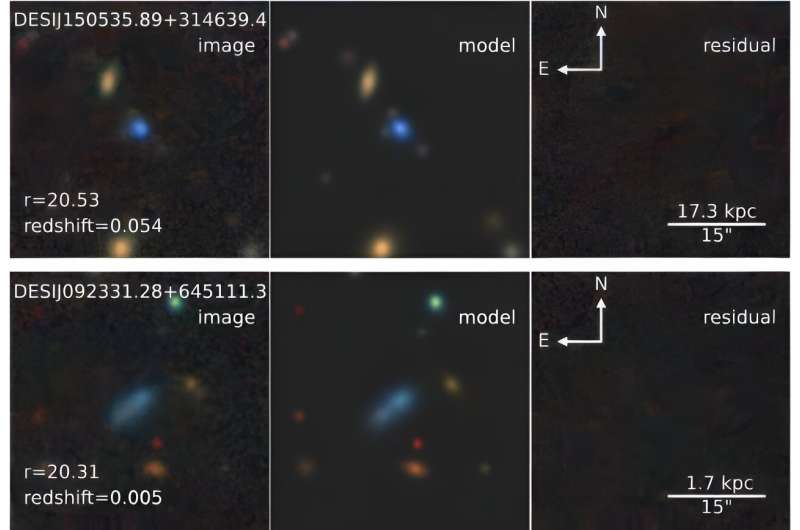December 15, 2023 report
This article has been reviewed according to Science X's editorial process and policies. Editors have highlighted the following attributes while ensuring the content's credibility:
fact-checked
preprint
trusted source
proofread
Astronomers detect almost 100 new extremely metal-poor galaxies

By analyzing the early data from the Dark Energy Spectroscopic Instrument (DESI), an international team of astronomers has identified 95 new extremely metal-poor galaxies at a low redshift. The finding is detailed in a paper published December 1 on the pre-print server arXiv.
Extremely metal-poor galaxies (XMPGs) are the ones with metallicity below 0.1 of the solar metallicity. Given that these galaxies are chemically unevolved, they can serve as excellent laboratories for investigating the chemical evolution theories of galaxies and studying the physical processes in the early stages of their evolution.
Although XMPGs are assumed to be quite common at high redshift, they are difficult to observe due to their low masses. Therefore, astronomers are interested in the observations of local XMPGs at low redshift, as they are perceived as possible analogs of primeval high-redshift young galaxies of this type in terms of mass and metallicity.
Now, a group of astronomers led by Hu Zou of the University of Chinese Academy of Sciences in Beijing, China, has obtained a large sample of XMPGs based on the early data from DESI.
"This work focuses on the analysis of DESI early data, including the Early Data Release (EDR; DESI Collaboration et al. 2023b), the detection of XMPGs and exploration of their mass-metallicity relation," the researchers wrote in the paper.
All in all, the team first selected 1,623 star-forming galaxies with significant oxygen emission lines detection. From this sample, they identified 223 extremely metal-poor galaxies at redshifts below 1.0. Finally, they confirmed 95 of them as bona fide XMPGs, while the 128 galaxies remain XMPG candidates.
Most of the XMPGs reported in the study were found at a low redshift of below 0.3 and turned out to be dwarf galaxies—with stellar masses not exceeding 1 billion solar masses. The most metal-poor galaxy in the sample, designated DESIJ150535.89+314639.4, has an oxygen abundance at a level of only 1/34 of that of the sun, has a stellar mass of about 15 million solar masses, and its star-forming rate was calculated to be 0.22 solar masses per year.
The astronomers noted that preliminary imaging examination of the two most metal-poor galaxies discovered from their sample revealed two different morphologies. This suggests different evolution and physical origins; however, further studies are required in order to confirm this hypothesis.
Summing up the results, the authors of the paper underlined that the extremely metal-poor galaxies detected by them are possibly low-redshift analogs of galaxies at high redshifts reaching 6.0 or even beyond. Therefore, they could be excellent objects for exploring the universe at its early stages of evolution.
More information: Hu Zou et al, A Large Sample of Extremely Metal-poor Galaxies at z<1 Identified from the DESI Early Data, arXiv (2023). DOI: 10.48550/arxiv.2312.00300
Journal information: arXiv
© 2023 Science X Network




















